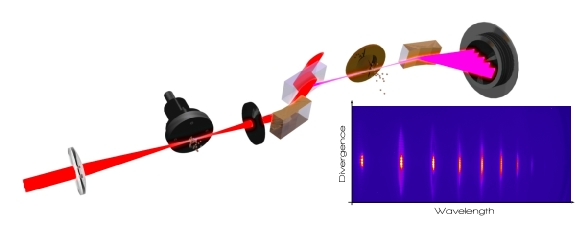Thierry Ruchon"s research pages
Overview |
High harmonics generation |
Attosecond pulses |
Attosecond XUV spectroscopy |
Equipment and methods |
Overview
At the core of our research is the upconversion process by which a femtosecond intense infrared laser field is converted into a series of odd harmonics of its fundamental frequency. We focus ourselves on the High Harmonics Generation process (HHG) in gases. It yields a very broad harmonic comb that extends in the XUV region of the spectrum. First, we use it to synthetize attosecond pulses, i.e. light pulses whose duration is in the the 10
-18 s range. Second, a careful analysis of the radiation allows us to study the properties of the atomic/molecular gases used for the upconversion in an Extreme Non Linear spectroscopy scheme. Finally these harmonics combs or attosecond pulses are used to study photoionization in pump/probe schemes where one beam is the remaining IR from the upconversion process.

In a typical experiment, a femtosecond laser (10-50 fs) is focused on a gas jet where it produces high energy photons through extreme non linear processes. These photons, which are in the XUV range are analysed on a photon spectrometer (inset) or used to study photoionization processes with charged particles detectors (intermediate gas inlet, e.g. Time of Flight (TOF) Magnetic Bottle Electron Spectrometer (MBES)).
